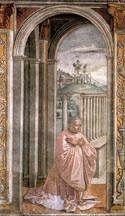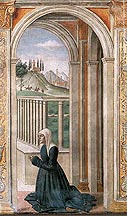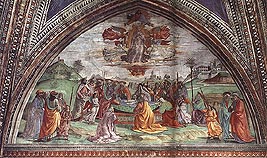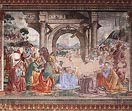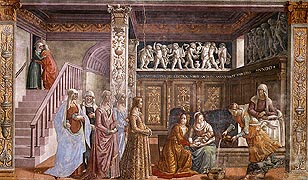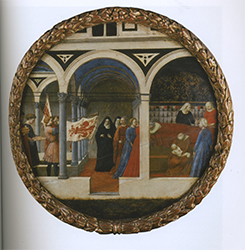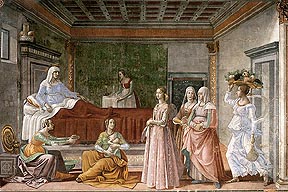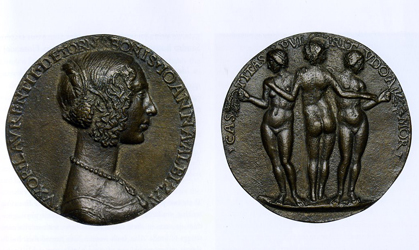Art Home | ARTH Courses | ARTH 213 Assignments
Civic Portraiture:
The Tornabuoni Chapel
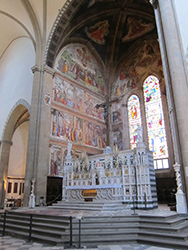 |
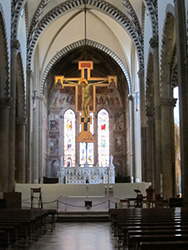 |
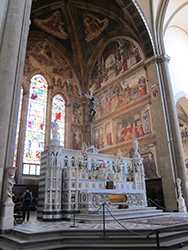 |
The following excerpt is from Paola Tinagli, Women in Italian Renaissance Art: Gender, Representation, Identity (Manchester, 1997):
/p. 64: Alberti mentions in On Painting the early fifteenth-century custom of introducing portraits of well-known and worthy citizens in religious narratives. This tradition continues in the family patronage of public religious commissions of the late fifteenth century. It also gives scope for female portraits to be included in a very important genre, that of collective civic portraiture. Perhaps the best example of a religious commission which stresses the significance of public display in such a context, while at the same time illustrating the difference of men's and women's ideal roles and behaviour in late fifteenth-century Florentine society, is provided by [a] series for frescoes by Ghirlandaio and his workshop. The decoration of the apse (cappella maggiore) of the Dominican church /p. 65: of Santa Maria Novella in Florence, commissioned by Giovanni Tornabuoni in 1485, was carried out between 1486 and 1490. This was the largest fresco commission in Florence in the last decades of the fifteenth century, for one of the most important churches of the city. Giovanni Tornabuoni was one of the wealthiest and most influential men in Florence, tied to the Medici by links forged by marriage, business and political interests. His sister Lucrezia was the wife of Piero de Medici and the mother of Lorenzo the Magnificent. In the same year as his sister's marriage, 1444, Giovanni had first entered the Medici bank. In 1465 he became the director and partner of the Medici bank in Rome, and eventually treasurer and financial adviser to Pope Sixtus IV....
On the end wall of their chapel in Santa Maria Novella, Giovanni appears with his wife Francesca Pitti. Both are simply dressed and are shown kneeling in prayer: Giovanni in three-quarter pose, hands crossed over his chest, his head bare, in a pale red robe. Francesca, who had died in childbirth in Rome in 1477 and had been buried in Santa Maria sopra Minerva, is shown in profile, hands joined, her clothing...a black gown without ornaments, with the veil worn by married women covering her head.
Two fresco cycles decorate the side walls of the apse. They illustrate the lives of the of the Virgin on the left...:
and of Giovanni's patron saint and patron saint of Florence, St John the Baptist, on the right...:
The portraits
of the members of the Tornabuoni family and of relatives, friends, allies
and clients of the Medici and the Tornabuoni are included as spectators
to the holy stories. The frescoes proclaim the Christian and civic virtues
of the patron, and, as the contract states, they were commissioned by
Giovanni
"as an act of piety and love of God, to the exaltation of his house
and family and the enhancement of the said church and chapel". On the
lower register of the right wall, in the fresco illustrating the 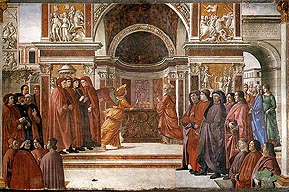 Annunciation to Zachariah, twenty-one male portraits are grouped
around the miraculous event, in front of an all' antica architectural
setting. Giovanni Tornabuoni stands in the most important place, at the
right of the angel, with his brother Leonardo and members of the other families
belonging to his own consorteria [lineage], the Tornaquinci. An
inscription on the arch at the right proclaims that in the year 1490 the
city of Florence, made beautiful by works of art and architecture, enjoyed
wealth, health and peace. Cristoforo Landino, Agnolo Poliziano and Marsilio
Ficino, the intellectual protagonists of Medicean Florence [lower left corner],
are included among the portraits as the living proofs of Florence's cultural
glory and superiority. The men responsible for this idealised view of the
city stand, some in profile, some in three-quarter, with their faces turning
towards each other or towards the viewer, as witnesses to a scene which gives
assurance to the miraculous continuation of the power of their family.
Annunciation to Zachariah, twenty-one male portraits are grouped
around the miraculous event, in front of an all' antica architectural
setting. Giovanni Tornabuoni stands in the most important place, at the
right of the angel, with his brother Leonardo and members of the other families
belonging to his own consorteria [lineage], the Tornaquinci. An
inscription on the arch at the right proclaims that in the year 1490 the
city of Florence, made beautiful by works of art and architecture, enjoyed
wealth, health and peace. Cristoforo Landino, Agnolo Poliziano and Marsilio
Ficino, the intellectual protagonists of Medicean Florence [lower left corner],
are included among the portraits as the living proofs of Florence's cultural
glory and superiority. The men responsible for this idealised view of the
city stand, some in profile, some in three-quarter, with their faces turning
towards each other or towards the viewer, as witnesses to a scene which gives
assurance to the miraculous continuation of the power of their family. 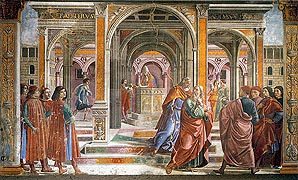 They
gesture gravely to each other, and are represented by the painter according
to the rules of decorum appropriate to their rank. Their faces are
fully characterised. They wear a cappuccio or a berretta on
their heads, and are wrapped in plain but expensive cremsi, vermiglio,
and pavonazzo robes and heavy cloaks which are like the uniforms
of their public offices and therefore signal their place in Florentine society.
Giovanni Tornabuoni, who had been elected Standard-Bearer of Justice for
the
quartiere (district) of St Maria Novella in 1482, in dressed in red.
[The strong civic symbolism should be understood in relationship to the
position of this fresco as introducing the cycle dedicated to John the Baptist,
the patron saint of Florence and the patron's name saint.]
They
gesture gravely to each other, and are represented by the painter according
to the rules of decorum appropriate to their rank. Their faces are
fully characterised. They wear a cappuccio or a berretta on
their heads, and are wrapped in plain but expensive cremsi, vermiglio,
and pavonazzo robes and heavy cloaks which are like the uniforms
of their public offices and therefore signal their place in Florentine society.
Giovanni Tornabuoni, who had been elected Standard-Bearer of Justice for
the
quartiere (district) of St Maria Novella in 1482, in dressed in red.
[The strong civic symbolism should be understood in relationship to the
position of this fresco as introducing the cycle dedicated to John the Baptist,
the patron saint of Florence and the patron's name saint.]
On the opposite wall, in the first narrative of the Life of the Virgin, Giovanni's son Lorenzo stands as a witness to Joachim being cast out of the Temple.
In the story
adjoining the Annunciation to Zachariah, the Visitation, it
is appropriately a female member of the Tornabuoni family who has been chosen
to witness the meeting between the Virgin Mary and St. Elizabeth, the moment
when the two holy women rejoice about each other's pregnancy. 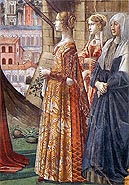 On
the right, a young woman, represented in strict profile, advances, accompanied
by two other women, one young, one old, whose heads are turned slightly towards
the viewer. She has been identified as Giovanna degli Albizzi, the wife of
Giovanni Tornabuoni's only son, Lorenzo. The three women, grave /p. 67:and
formal, stand against the background of a cityscape, their arms folded, their
hands clasped at the waist, Giovanna holding a handkerchief. Her gold brocade
giornea is woven with heraldic devices --the Tornabuoni diamond together
with doves and sunbursts. An "L" for Lorenzo is embroidered on her
shoulder. Her small head, with her blond hair tied in a knot at the back and
left loose in curls on her cheeks, is supported by a long columnar neck.
On
the right, a young woman, represented in strict profile, advances, accompanied
by two other women, one young, one old, whose heads are turned slightly towards
the viewer. She has been identified as Giovanna degli Albizzi, the wife of
Giovanni Tornabuoni's only son, Lorenzo. The three women, grave /p. 67:and
formal, stand against the background of a cityscape, their arms folded, their
hands clasped at the waist, Giovanna holding a handkerchief. Her gold brocade
giornea is woven with heraldic devices --the Tornabuoni diamond together
with doves and sunbursts. An "L" for Lorenzo is embroidered on her
shoulder. Her small head, with her blond hair tied in a knot at the back and
left loose in curls on her cheeks, is supported by a long columnar neck. 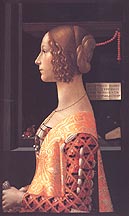 Her
stiff garments fall heavily to the ground as she walks, looking decorously
in front of her, in the measured manner appropriate to her gender and status.
Her image is at the same time the representation of in individual and of an
ideal of beauty and decorum. It establishes her as an icon of female
perfection [compare Giovanna's portrait in the Visitation to Giovanna's
portrait by Ghirlandaio]. Lorenzo the Magnificent described this ideal
when writing about another famous young woman in Florence, Simonetta Carraneo
Vespucci, in his Commento...Sopra Alcuni dei Suoi Sonetti. The image
of beauty he conjures with his words belongs to a convention which is derived
from Dante's description of Beatrice in the Vita Nuova, rather than
to an individual, and could be easily applied also to Giovanna degli Albizzi:
Her
stiff garments fall heavily to the ground as she walks, looking decorously
in front of her, in the measured manner appropriate to her gender and status.
Her image is at the same time the representation of in individual and of an
ideal of beauty and decorum. It establishes her as an icon of female
perfection [compare Giovanna's portrait in the Visitation to Giovanna's
portrait by Ghirlandaio]. Lorenzo the Magnificent described this ideal
when writing about another famous young woman in Florence, Simonetta Carraneo
Vespucci, in his Commento...Sopra Alcuni dei Suoi Sonetti. The image
of beauty he conjures with his words belongs to a convention which is derived
from Dante's description of Beatrice in the Vita Nuova, rather than
to an individual, and could be easily applied also to Giovanna degli Albizzi:
| Her beauty was wonderful...she was of an attractive and ideal height; the tone of her skin, white but not pale, fresh but not glowing; her demeanour was grave but not proud, sweet, and pleasing, without frivolity or fear. Her eyes were lively and her gaze restrained, without trace of pride or meanness; her body was so well proportioned, that among other women she appeared dignified...in walking and in dancing...and in all her movements she was elegant and attractive; her hands were the most beautiful that Nature could create. She dressed in those fashions which suited a noble and gentle lady.... |
Giovanna degli Albizzi had married Lorenzo Tornabuoni in 1486 when she was not yet eighteen years old -- a marriage arranged through the mediation of Lorenzo's cousin, Lorenzo the Magnificent....
The marriage had been a sumptuous occasion, marking the union of two among the most important and oldest Florentine families which in the first half of the century had been political enemies. A cortège of one hundred well-born girls and fifteen young men had accompanied Giovanna to the cathedral of Florence, Santa Maria del Fiore, where the wedding ring was given to her in presence of the Spanish ambassador to the Pope. The festivities included banquets and dances organised on wooden platforms, specially built for the occasion next to the Tornabuoni and the Albizzi palaces. In October 1487, Giovanna had given birth to Giovanni Tornabuoni's first grandson, who had been also called Giovanni. By the time Ghirlandaio painted her portrait in the Visitation, she was already dead. She died one year after the birth of her son, during a new pregnancy, and was buried in S. Maria Novella.
Giovanni's posthumous portrait in this cycle confirms to posterity the /p. 70: importance of her place amongst the Tornabuoni, as she was the means through which the family name was transmitted to a new generation. The hieratic character of her image is stressed, through the repetition of pose and garments, by another portrait painted in the story facing the Visitation fresco....
|
Masaccio, Birth Scene. |
On the lower
register of the opposite wall, as a witness to the Birth of the Virgin
Mary which takes place in a contemporary Florentine bedroom,  another
young Tornabuoni woman, Lodovica, the only daughter of the patron stands in
front of a group of companions. Her pose is almost identical to Giovanna degli
Albizzi's and she wears a giornea of the same fabric and colour, decorated
with the same heraldic motifs. In 1490 Lodovica was only fourteen, and she
appears to the viewer as the ideal young virginal girl, modest and beautiful.
A younger version of her characteristic profile can be seen in a medal, almost
certainly cast in 1486.
another
young Tornabuoni woman, Lodovica, the only daughter of the patron stands in
front of a group of companions. Her pose is almost identical to Giovanna degli
Albizzi's and she wears a giornea of the same fabric and colour, decorated
with the same heraldic motifs. In 1490 Lodovica was only fourteen, and she
appears to the viewer as the ideal young virginal girl, modest and beautiful.
A younger version of her characteristic profile can be seen in a medal, almost
certainly cast in 1486. 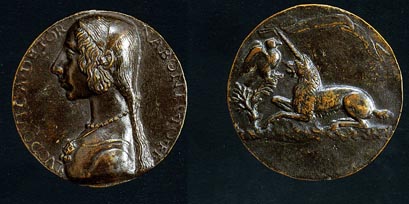 On the reverse of the medal, a unicorn, symbol of
virginity, kneels in front of a dove perched on a tree --and a dove on a branch
/p. 71: is one of the motifs woven into her gold brocade gown. In 1491 Ludovica
married Alessandro di Francesco Nasi, whose portrait is painted next to that
of her brother Lorenzo in the Joachim story.
On the reverse of the medal, a unicorn, symbol of
virginity, kneels in front of a dove perched on a tree --and a dove on a branch
/p. 71: is one of the motifs woven into her gold brocade gown. In 1491 Ludovica
married Alessandro di Francesco Nasi, whose portrait is painted next to that
of her brother Lorenzo in the Joachim story.
A third, unidentified, young woman stands almost at the centre of another story, the Birth of John the Baptist, on the second register of the right wall. This time her portrait is not in the usual profile pose: she turns her head and gaze towards the viewer, holding a handkerchief in her clasped hands, and wearing a pink giornea decorated with small gold motifs over a creamy cioppa embroidered with flowers and pomegranates. An ink study for the clothing of this figure in the British Museum shows the importance given to the accurate rendering of the details of her giornea, with its side openings cut into decorative leaf shapes and the sleeves of the cioppa slashed to show the thin fabric of the camicia. Behind this richly dressed young woman is a portait of an older woman, plainly dressed, which has been identified as /p. 72: the patron's sister, Lucrezia Tornabuoni. According to fifteenth century manuals on behaviour and manners, clothing had to be appropriate not only to social rank and income, but also to age. Lucrezia Tornabuoni, who belonged by marriage to the most powerful Florentine family, the Medici, plays here only a supporting role, with her simple gown almost hidden by a cloak and a white cloth which covers her head.
The three young women, two shown in profile, one in three-quarter pose, attract the attention of the viewer because of their beauty and the richness of their gowns. They occupy a privileged place in the three stories in which they appear and which, appropriately, deal with pregnancy and birth. The way they have been represented, with their identical stance, the heavy garments which completely hide their bodies, their facial features idealised according to a similar type of beauty, and the absence of any gesture, contrasts with the simpler clothing, the more varied physical characteristics, ages and countenances of their companions. But there is an even more marked contrast, in these frescoes, between the representations of those women who stand as spectators, and which are recognisable as portraits, and the idealised figures who take part in the sacred narrative. The latter show the use of a variety of gestures and facial expressions to communicate emotion and meaning appropriate to their role in the narrative. In the Birth of the Virgin Mary the woman who sits holding the baby smiles expressively while another, pouring water from a pitcher, steps forward with her clothes fluttering behind her, revealing her ankles. In the Birth of John the Baptist an attendant rushes through a door on the right, holding a tray of fruit over her head. Her light clothes reveal her figure, while a wisp of hair and a veil indicate the speed of her movement. The difference could not be more obvious: the slow and measured step of the 'real' women, and the absence of any gesture show the formality of an ideal mode of behaviour and a consciousness of social status, which is reinforced by the movements and the appearance of the fictitious characters. The images of the three young women are singled out by their place in the composition, by their appearance and behaviour. Beauty, demeanour and the wealth of their clothes mark them as belonging to a privileged group.
These civic portraits speak of the different ideal roles for men and women. Gravitas and decorum are indispensable to both, but the similarities end there. The male portraits identify for the viewer the protagonists of the political organisation of the city, presented as the makers of social order and prosperity. The Florentine male elite proclaims the power which derives from family lineage and alliances, and their individualised features placed above the austere uniformity of their garments speak of an ideal world of civic virtue. The women, brides or brides-to-be, essential to their relatives' plans for the continuation of /p. 73: lineage, dressed in their opulent, expensive clothes, their necks decorated with jewels, their virtues signified by their measured step and by their folded hands, operate in a world concerned with marrige and childbirth. In the public space of the church of Santa Maria Novella, the frescoes commissioned by Giovanni Tornabuoni show how the representations of men and women follow different conventions which are regulated in part by social realities and in part by shared ideals.
Dale Kent in Virtue and Beauty, 40: Domenico Ghirlandaio, on the frescoed walls of the family chapels of the Sassetti and Tornabuoni, produced portraits of individuals embedded in the groups kinsmen, friends, and neighbors that were their social context. Commissioned in 1485 by Giovanni Tornabuoni, Lucrezia's brother, who was papal treasurer and manager of the Medici Bank, the frescoes in Santa Maria Novella represented the patron's conception of his family, distinguished citizens offering prayers to God for the preservation of the lineage in this world and its salvation in the next. [these prayers are articulated in the inscriptions of the Tornabuoni panels; see Patricia Simons, "Patronage in the Tornaquinci Chapel, Santa Maria Novella," in Patronage, Art and Society in Renaissance Italy ed. F. W. Kent and Patricia Simons (Oxford, 1987), p. 239-240.]
In the chapel...,
Giovanni and [his wife] Francesca [di Luca Pitti] preside eternally over an
affirmation of the continuity of life and the family and the city of Florence,
represented by the scenes of the Birth of John the Baptist and from the life
of the Virgin. In these scenes, at once holy and domestic, may be identified
the portraits of many of the Tornabuoni women, among them Giovanni's daughter
Lodovica,  attending
at the Birth of the Virgin. His sister Lucrezia Tournabuoni, patron
of a chapel dedicated to the Visitation in the Medici parish church of San
Lorenzo, may appear in the
attending
at the Birth of the Virgin. His sister Lucrezia Tournabuoni, patron
of a chapel dedicated to the Visitation in the Medici parish church of San
Lorenzo, may appear in the  Tornabuoni
Visitation, along with both the first and second wives of the patron's
son Lorenzo.
Tornabuoni
Visitation, along with both the first and second wives of the patron's
son Lorenzo.
Lorenzo's first wife, Giovanna degli Albizzi, was portrayed after her death in a portrait by Ghirlandaio wearing the same dress as in the fresco and on a medal in the style of Niccolò Fiorentino. She may be identified alson in the Birth of John the Baptist, but by contrast with the Tornabuoni men, less on the basis of her features than by her distinctive pendant that appears in her commemorative portrait, and in both the chapel fresco panels.
 Inscribed
on a building painted behind an image of St. Zacharias are the words "In
the year 1490 when the most glorious city, renowned for its wealth, its victories,
its art and architecture, lived in affluence, prosperity and peace."
Inscribed
on a building painted behind an image of St. Zacharias are the words "In
the year 1490 when the most glorious city, renowned for its wealth, its victories,
its art and architecture, lived in affluence, prosperity and peace."
The architectural
context with the vaulted ceiling and relief sculpture unmistakably draw
connections to Roman architecture and sculpture. For example the relief
sculptures come very close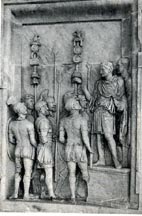 to
a series of reliefs
made for Marcus Aurelius. The point would not have been missed on a
Florentine that Florence was being constructed as a new Rome. Is there
a programatic relationship between the painted reliefs and the scene in
front of it? The angelic salutation to Zacharias appears to be echoed in
the ad locutio gesture in the relief behind the group on the
right. The relief in the upper right corner shows the crowning of an emperor
by a Nike figure.
to
a series of reliefs
made for Marcus Aurelius. The point would not have been missed on a
Florentine that Florence was being constructed as a new Rome. Is there
a programatic relationship between the painted reliefs and the scene in
front of it? The angelic salutation to Zacharias appears to be echoed in
the ad locutio gesture in the relief behind the group on the
right. The relief in the upper right corner shows the crowning of an emperor
by a Nike figure. 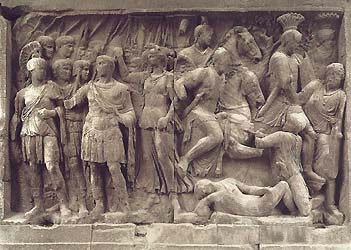 The
scene is clearly modeled on The Great Trajanic Frieze. The Nike
figure signifies divine sanction, and it is not by chance that this appears
directly above the prominent members of the Tornabuoni family. The inclusion
of both the Trajanic and Aurelian reliefs on the Arch
of Constantine would be of significance to the Florentine audience
since Constantine was the first Christian Roman Emperor.
The
scene is clearly modeled on The Great Trajanic Frieze. The Nike
figure signifies divine sanction, and it is not by chance that this appears
directly above the prominent members of the Tornabuoni family. The inclusion
of both the Trajanic and Aurelian reliefs on the Arch
of Constantine would be of significance to the Florentine audience
since Constantine was the first Christian Roman Emperor.
The fresco thus attests to the magnificence of Florence and the Tornabuoni family in particular.The lavish architectural context based on Roman monuments draws the comparison between ancient Rome and new building campaigns of Florence. A contemporary Florentine, Luca Landucci, kept in his diary a record of the magnificent new buildings and other projects underway. Included in this list is the Tornabuoni Chapel whose paintings alone cost the considerable sum of a 1,000 florins. The red cloaks and caps of many of the prominent men attests to the importance of civic government and the important role the Tornabuoni family plays in the political life of the city. The intellectuals in the lower left corner signify the role cultural life and patronage plays in the enhancement of civic life. The patriarchal nature of this civic world is suggested by the positioning of some of the Tornabuoni women under the arch on the right hand side of the fresco, on the margins of the civic space.
Excerpts from the artist's contract: "he [Domenico Ghirlandaio] is to paint and depict figures, buildings, castles, cities, mountains, hills, plains, water, rocks, garments, birds and beasts, of whatever kind as seems proper to the said Giovanni, but according to the stipulation of colours and gold as laid down above; and he should apply and paint all the arms which the said Giovanni should require on any part according to his own wish and pleasure." "to the praise, magnitude, and honour of Almighty God and His glorious Mother, ever Virgin, and of St John, St Dominic and other saints as detailed below, and of the whole host of heaven, the magnificent and noble Giovanni, son of Francesco Tornabuoni, citizen and merchant of Florence, has proposed, as patron of the greater chapel in the church of S. Maria Novella in Florence, to decorate the said chapel with noble, worthy, exquisite and decorative paintings at his own expense as an act of piety and love of God, to the exaltation of his house and family and the enhancement of the said church and chapel."
